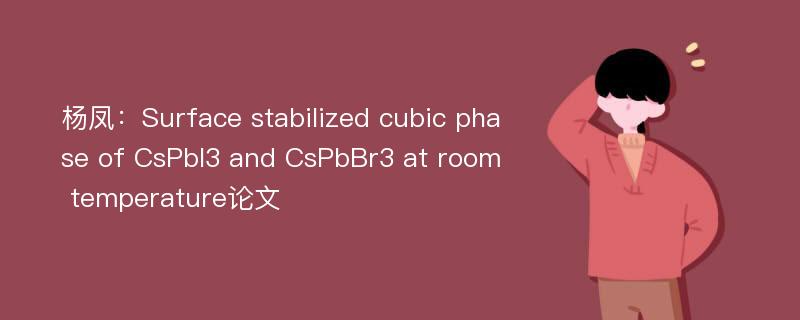
本文主要研究内容
作者杨凤,王聪,潘宇浩,周谐宇,孔祥华,季威(2019)在《Surface stabilized cubic phase of CsPbI3 and CsPbBr3 at room temperature》一文中研究指出:Inorganic halide perovskites CsPb X3(X = I, Br) have attracted tremendous attention in solar cell applications. However, the bulk form of the cubic phase CsPb X3, which offers moderate direct bandgaps, is metastable at room temperature and tends to transform into a tetragonal or orthorhombic phase. Here, our density functional theory calculation results found that the surface energies of the cubic phase are smaller than those of the orthorhombic phase, although the bulk counterpart of the cubic phase is less stable than that of the orthorhombic phase. These results suggest a surface stabilization strategy to maintain the stability of the cubic phase at room temperature that an enlarged portion of surfaces shall change the relative stability of the two phases in nanostructured CsPb X3. This strategy, which may potentially solve the long-standing stability issue of cubic CsPb X3, was demonstrated to be feasible by our calculations in zero-, one-, and two-dimensional nanostructures. In particular, confined sizes from few to tens of nanometers could keep the cubic phase as the most thermally favored form at room temperature. Our predicted values in particular cases, such as the zero-dimensional form of CsPbI3,are highly consistent with experimental values, suggesting that our model is reasonable and our results are reliable. These predicted critical sizes give the upper and lower limits of the confined sizes, which may guide experimentalists to synthesize these nanostructures and promote likely practical applications such as solar cells and flexible displays using CsPb X3nanostructures.
Abstract
Inorganic halide perovskites CsPb X3(X = I, Br) have attracted tremendous attention in solar cell applications. However, the bulk form of the cubic phase CsPb X3, which offers moderate direct bandgaps, is metastable at room temperature and tends to transform into a tetragonal or orthorhombic phase. Here, our density functional theory calculation results found that the surface energies of the cubic phase are smaller than those of the orthorhombic phase, although the bulk counterpart of the cubic phase is less stable than that of the orthorhombic phase. These results suggest a surface stabilization strategy to maintain the stability of the cubic phase at room temperature that an enlarged portion of surfaces shall change the relative stability of the two phases in nanostructured CsPb X3. This strategy, which may potentially solve the long-standing stability issue of cubic CsPb X3, was demonstrated to be feasible by our calculations in zero-, one-, and two-dimensional nanostructures. In particular, confined sizes from few to tens of nanometers could keep the cubic phase as the most thermally favored form at room temperature. Our predicted values in particular cases, such as the zero-dimensional form of CsPbI3,are highly consistent with experimental values, suggesting that our model is reasonable and our results are reliable. These predicted critical sizes give the upper and lower limits of the confined sizes, which may guide experimentalists to synthesize these nanostructures and promote likely practical applications such as solar cells and flexible displays using CsPb X3nanostructures.
论文参考文献
论文详细介绍
论文作者分别是来自Chinese Physics B的杨凤,王聪,潘宇浩,周谐宇,孔祥华,季威,发表于刊物Chinese Physics B2019年05期论文,是一篇关于,Chinese Physics B2019年05期论文的文章。本文可供学术参考使用,各位学者可以免费参考阅读下载,文章观点不代表本站观点,资料来自Chinese Physics B2019年05期论文网站,若本站收录的文献无意侵犯了您的著作版权,请联系我们删除。
